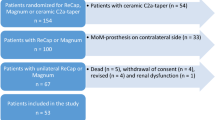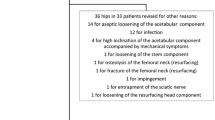Abstract
Background
Impingement of the femoral neck with the acetabular component after metal-on-metal hip resurfacing arthroplasty (HRA) is a possible cause of edge loading and accelerated bearing wear. No attempt has been made to correlate radiographic impingement signs and blood metal ion levels.
Questions/purposes
We (1) compared serum cobalt (CoS) and chromium (CrS) concentrations between patients with and without radiographic impingement signs treated with unilateral HRA, (2) determined whether divot depth on the femoral neck correlated with CoS and CrS, and (3) assessed the predictive value of radiographic impingement signs for high levels of CoS and CrS.
Methods
A retrospective radiographic review of 141 patients with CoS and CrS analyses yielded 21 patients with and 120 without radiographic impingement signs (controls). Radiographic measurements included divot depth and orientation of the acetabular component to compute the contact patch to rim distance, a measure of functional head coverage. We defined a patient as having radiographic impingement signs if a remodeling of the femoral neck cortex showed a depression matching the predicted path of an impinging acetabular component. CoS and CrS were analyzed by inductively coupled plasma mass spectrometry and the radiographs were taken within 12 months of the last blood draw.
Results
Median CoS and CrS were greater in the impingement group than in controls in patients with less than 10-mm contact patch to rim distances. Divot depth did not correlate with CoS or CrS. In predicting elevated ion levels (≥ 7 μg/L), the presence of a radiographic impingement sign showed a sensitivity of 50% for CoS and 33% for CrS and a specificity of 87% for both CoS and CrS.
Conclusions
Radiographic impingement signs influenced CoS and CrS only when the functional head coverage was insufficient due to poor socket positioning. Radiographic impingement signs alone were not a good predictor of elevated metal ion levels.
Level of Evidence
Level III, diagnostic study. See Instructions for Authors for a complete description of levels of evidence.




Similar content being viewed by others
References
Amstutz HC. “Top 10” technical pearls for successfully performing hip resurfacing arthroplasty. Tech Orthop. 2010;25:73–79.
Amstutz HC, Beaulé PE, Dorey FJ, Le Duff MJ, Campbell PA, Gruen TA. Metal-on-metal hybrid surface arthroplasty—surgical technique. J. Bone Joint Surg. Am. 2006;88:234–249.
Amstutz HC, Campbell PA, Dorey FJ, Johnson AJ, Skipor A, Jacobs JJ. Do ion concentrations after metal-on-metal hip resurfacing increase over time? A prospective study. J Arthroplasty. 2013;28:695–700.
Amstutz HC, Le Duff MJ. Background of metal-on-metal resurfacing. Proc Inst Mech Eng H. 2006;220:85–94.
Amstutz HC, Le Duff MJ, Campbell PA, Dorey FJ. The effects of technique changes on aseptic loosening of the femoral component in hip resurfacing: results of 600 Conserve Plus with a 3–9 year follow-up. J Arthroplasty. 2007;22:481–489.
Amstutz HC, Le Duff MJ, Johnson AJ. Socket position determines hip resurfacing 10-year survivorship. Clin Orthop Relat Res. 2012;470:3127–3133.
Back DL, Young DA, Shimmin AJ. How do serum cobalt and chromium levels change after metal-on-metal hip resurfacing? Clin Orthop Relat Res. 2005;438:177–181.
Ball ST, Schmalzried TP. Posterior femoroacetabular impingement (PFAI)—after hip resurfacing arthroplasty. Bull NYU Hosp Jt Dis. 2009;67:173–176.
Bergmann G, Deuretzbacher G, Heller M, Graichen F, Rohlmann A, Strauss J, Duda GN. Hip contact forces and gait patterns from routine activities. J Biomech. 2001;34:859–871.
Biedermann R, Tonin A, Krismer M, Rachbauer F, Eibl G, Stockl B. Reducing the risk of dislocation after total hip arthroplasty: the effect of orientation of the acetabular component. J Bone Joint Surg Br. 2005;87:762–769.
Grigoris P, Roberts P, Panousis K, Bosch H. The evolution of hip resurfacing arthroplasty. Orthop Clin North Am. 2005;36:125–134.
Gruen TA, Le Duff MJ, Wisk LE, Amstutz HC. Prevalence and clinical relevance of radiographic signs of impingement in metal-on-metal hybrid hip resurfacing. J Bone Joint Surg Am. 2011;93:1519–1526.
Heisel C, Streich N, Krachler M, Jakubowitz E, Kretzer JP. Characterization of the running-in period in total hip resurfacing arthroplasty: an in vivo and in vitro metal ion analysis. J Bone Joint Surg Am. 2008;90:125–133.
Johnson CR. A new method for roentgenographic examination of the upper end of the femur. J Bone Joint Surg. 1932;14:859–866.
Langton DJ, Joyce TJ, Mangat N, Lord J, Van Orsouw M, De Smet K, Nargol AV. Reducing metal ion release following hip resurfacing arthroplasty. Orthop Clin North Am. 2011;42:169–180.
Langton DJ, Sprowson AP, Joyce TJ, Reed M, Carluke I, Partington P, Nargol AV. Blood metal ion concentrations after hip resurfacing arthroplasty: a comparative study of articular surface replacement and Birmingham hip resurfacing arthroplasties. J Bone Joint Surg Br. 2009;91:1287–1295.
Langton DJ, Sprowson AP, Mahadeva D, Bhatnagar S, Holland JP, Nargol AV. Cup anteversion in hip resurfacing: validation of EBRA and the presentation of a simple clinical grading system. J Arthroplasty. 2009;25:607–613.
Leslie IJ, Williams S, Isaac G, Ingham E, Fisher J. High cup angle and microseparation increase the wear of hip surface replacements. Clin Orthop Relat Res. 2009;467:2259–2265.
Lim SJ, Kim JH, Moon YW, Park YS. Femoroacetabular cup impingement after resurfacing arthroplasty of the hip. J Arthroplasty. 2012;27:60–65.
MacDonald SJ, McCalden RW, Chess DG, Bourne RB, Rorabeck CH, Cleland D, Leung F. Metal-on-metal versus polyethylene in hip arthroplasty: a randomized clinical trial. Clin Orthop Relat Res. 2003;406:282–296.
Matthies A, Underwood R, Cann P, Ilo K, Nawaz Z, Skinner J, Hart AJ. Retrieval analysis of 240 metal-on-metal hip components, comparing modular total hip replacement with hip resurfacing. J Bone Joint Surg Br. 2011;93:307–314.
Medicines and Healthcare products Regulatory Agency. Medical Device Alert. All metal-on-metal (MoM) hip replacements (MDA/2012/008). Available at: http://www.mhra.gov.uk/home/groups/dts-bs/documents/medicaldevicealert/con143787.pdf. Accessed October 12, 2012.
Morlock MM, Bishop N, Zustin J, Hahn M, Ruther W, Amling M. Modes of implant failure after hip resurfacing: morphological and wear analysis of 267 retrieval specimens. J Bone Joint Surg Am. 2008;90:89–95.
Pulos N, Tiberi JV 3rd, Schmalzried TP. Measuring acetabular component position on lateral radiographs—ischio-lateral method. Bull NYU Hosp Jt Dis. 2011;69(suppl 1):S84–S89.
Savarino L, Granchi D, Ciapetti G, Cenni E, Nardi Pantoli A, Rotini R, Veronesi C, Baldini N, Giunti A. Ion release in patients with metal-on-metal hip bearings in total joint replacement: a comparison with metal-on-polyethylene bearings. J Biomed Mater Res. 2002;63:467–474.
Skipor AK, Campbell PA, Paterson LM, Amstutz HC, Schmalzried TP, Jacobs JJ. Serum and urine metal levels in patients with metal-on-metal surface arthroplasty. J Mater Sci Mater Med. 2002;13:1227–1234.
Tiberi JV, Pulos N, Kertzner M, Schmalzried TP. A more reliable method to assess acetabular component position. Clin Orthop Relat Res. 2012;470:471–476.
Underwood RJ, Zografos A, Sayles RS, Hart AJ, Cann P. Edge loading in metal-on-metal hips: low clearance is a new risk factor. Proc Inst Mech Eng H. 2012;226:217–226.
Van Der Straeten C, Grammatopoulos G, Gill HS, Calistri A, Campbell P, De Smet KA. The 2012 Otto Aufranc Award. The interpretation of metal ion levels in unilateral and bilateral hip resurfacing. Clin Orthop Relat Res. 2013;471:377–385.
Yoo MC, Cho YJ, Chun YS, Rhyu KH. Impingement between the acetabular cup and the femoral neck after hip resurfacing arthroplasty. J Bone Joint Surg Am. 2011;93:99–106.
Yoon JP, Le Duff MJ, Johnson AJ, Takamura KM, Ebramzadeh E, Amstutz HC. Contact patch to rim distance predicts metal ion levels in hip resurfacing. Clin Orthop Relat Res. 2013;471:1615–1621.
Author information
Authors and Affiliations
Corresponding author
Additional information
One of the authors (HCA) certifies that he has received or may receive payments or benefits, during the study period, an amount of USD 10,000 to USD 100,000), from Wright Medical Technology Inc (Arlington, TN, USA).
All ICMJE Conflict of Interest Forms for authors and Clinical Orthopaedics and Related Research editors and board members are on file with the publication and can be viewed on request.
Clinical Orthopaedics and Related Research neither advocates nor endorses the use of any treatment, drug, or device. Readers are encouraged to always seek additional information, including FDA approval status, of any drug or device before clinical use.
Each author certifies that his or her institution approved the human protocol for this investigation, that all investigations were conducted in conformity with ethical principles of research, and that informed consent for participation in the study was obtained.
About this article
Cite this article
Le Duff, M.J., Johnson, A.J., Wassef, A.J. et al. Does Femoral Neck to Cup Impingement Affect Metal Ion Levels in Hip Resurfacing?. Clin Orthop Relat Res 472, 489–496 (2014). https://doi.org/10.1007/s11999-013-3074-8
Published:
Issue Date:
DOI: https://doi.org/10.1007/s11999-013-3074-8




